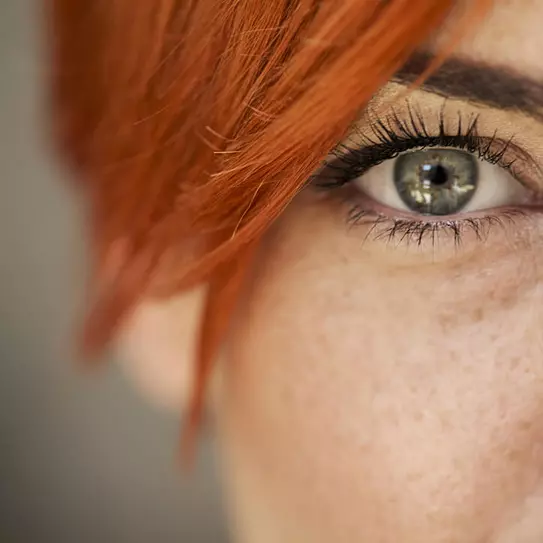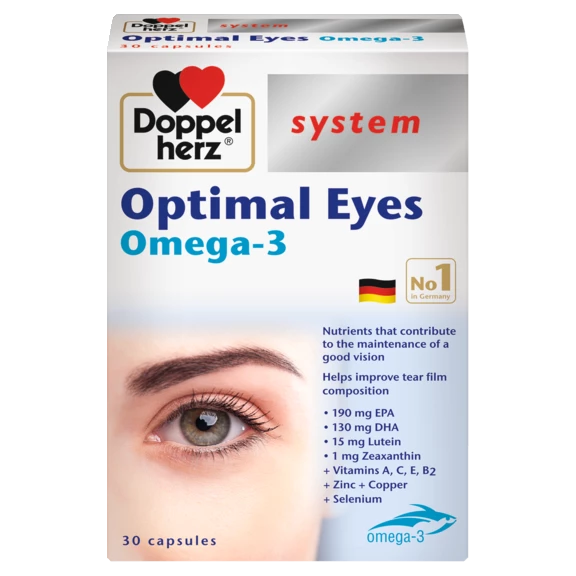The eye – Better than any technology!
No camera can do what our eyes do every day. We can differentiate between some 150 hues of the spectrum of visible light and combine them into a half million colour sensations. We recognise objects at lightning speed with amazing sharpness and spatial contrasts.
Our eyes adapt effortlessly to every distance and to all lighting conditions. Our eyes are considered as a miraculous creation of nature, and justifiably so!
Today we know that vision provides us with about 80% of all our environmental information. The brain requires more than one third of its entire capacity in order to process the visual impressions which the eye supplies. Reason enough for us to want to preserve our vision for a long, long time!

A feast for the eyes
Starting around the age of 40, natural vision generally begins to wane. But proper nutrition combined with healthy habits such as abstaining from cigarettes or wearing sunglasses to protect against UV radiation are the first steps toward better eye health and maintaining good vision at all ages.
Doctors recommend eating “five servings of fruits and vegetables each day” in order to cover the normal requirements for vitamins and trace elements. And the metabolism of the eyes also benefit from this.
Nutrients such as certain vitamins and trace elements help eliminate free radicals through an antioxidant protection system, which in turn helps protect cell components from oxidative stress. The main substances involved in that protection system are the trace elements selenium, zinc and copper and the vitamins C and E.
Vitamin A – The classic vitamin for the eyes
The best-known nutrient connected with visual function and ocular health is vitamin A. The fact that vitamin A contributes to the preservation of normal vision is why it has come to be called the “eye vitamin.”
Vitamin A is involved in building the retinal pigments of the rods in the retina, which are responsible for mesopic vision (the ability to see in twilight). Particularly stressful conditions such as extended television viewing, working at computer screens, or frequent night-time driving can increase the need for vitamin A. And exposure to intense sunlight also eliminates vitamin A in the eye itself.
The body can transform some carotinoids into pure vitamin A. These also include beta-carotene, which gets its name from carrot and gives the latter its orange colour. That’s why carrots are commonly touted as a food which promotes good eyesight.
Offal such as liver is particularly rich in vitamin A, but it is also found in high concentrations in oily fish such as herring or mackerel. Eggs and high-fat varieties of cheese are also good sources of vitamin A. Adults should take in 0.8 – 1.0 mg of vitamin A daily.
Lutein + Zeaxanthin – Components of the macula
A specific area of the retina is responsible for clear, high-contrast vision: the macula lutea (Latin for “yellow spot”). The “yellow spot” is aptly named. The yellow colour is attributable to the plant pigments lutein and zeaxanthin, which are found there in high concentrations.
More than other areas of the eye, the macula is struck by nearly unrefracted sunlight and therefore particularly exposed to the damaging oxidative effect of the light. Lutein and zeaxanthin are considered the adversaries of the radicals and are often described as components of the “natural sunglasses of the eye.”
Lutein and zeaxanthin are found mainly in vegetables such as kale, parsley, asparagus or raw spinach.

Omega fatty acid DHA – For brain and photoreceptor cells
The polyunsaturated omega-3 fatty acids are considered especially valuable and healthy – above all eicosapentaenoic acid (EPA) and docosahexaenoic acid (DHA).
A what really catches the eye: omega-3 fatty acids also play an important role in maintaining the health of the eyes.
Docosahexaenoic acid (DHA) is the most abundant fatty acid in the brain and in the photoreceptor cells. It is important for the structure of the retina and for that reason contributes to the preservation of normal vision.
The ocular fundus is not the only part of the eye which contains fat, however – the outer layer of the tear film also does as well. A healthy tear film ensures that the tear fluid does not evaporate, thereby keeping the eyes well moistened.
Since the body cannot form omega-3 fatty acids on its own without the corresponding precursors, they must be regularly taken in with food. Cold water fish such as herring, mackerel and salmon are particularly rich in omega-3 fatty acids.
The Doppelherz nutritional supplement system AUGEN SEHKRAFT+SCHUTZ (EYES VISION+PROTECTION) helps ensure that the body receives an adequate supply of important nutrients – already with just 2 capsules per day.
In so doing, the Doppelherz system AUGEN SEHKRAFT+SCHUTZ (EYES VISION+PROTECTION) helps preserve normal vision and protect against oxidative stress.
